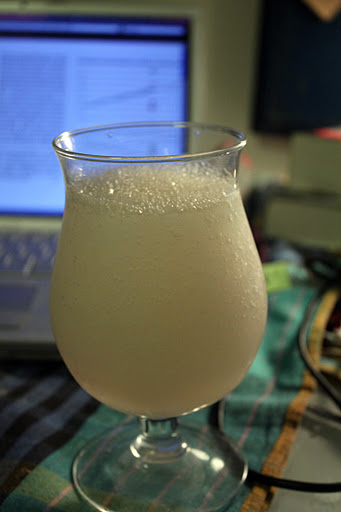-
Posts
2,823 -
Joined
-
Last visited
Content Type
Profiles
Forums
Store
Help Articles
Posts posted by Hassouni
-
-
FWIW Baozi Inn is by the same people as Bar Shu, at least I'm pretty sure. it's very informal, with a small menu though, so if you're after fuqi feipian or shizhou yu they won't have it (and know you know my go-to Sichuanese dishes
 )
) -
By the way, not Sichuan, but Golden Days on Shaftesbury Avenue does really great, very authentic Hunan fare at very reasonable prices, so if Bar Shu is too expensive, you might consider that
-
A nakiri is closer to a traditional Japanese kitchen knife (which would be an usuba), whereas a santoku is kind of a compromise. Personally I've never used a nakiri, and I don't think I'll need one, owning a gyutou.
What I can say is, once you go Japanese, you will never go back to Western knives
-
Very nice Tokonome, Hassouni. Are you sure it's unglazed? The glossy surface reflections made me ask.
If you're referring to the inside of the pot, it's glossy because I had just rinsed it out to remove any packing/workshop dust, etc. When dry it has a somewhat matte appearance - not rough, but definitely not shiny.
-
Anyone heard of/had 'Nduja, that killer-good hot spreadable sausage from Calabria? I think it's a corruption of andouille, but not sure how to pronounce it, since j isn't standard Italian. N-dooya?
That's correct" "ndoo-yah." And it does come from andouille.
"J" may not be standard Italian now, but appears in plenty of dialectical and historical spellings (e.g., Jesi and Jacopo). It's origin was as a variant of "i."
Yeah I know J was a variant of I but just wasn't sure. Cool! Any place I can get it in the States?
-
Anyone heard of/had 'Nduja, that killer-good hot spreadable sausage from Calabria? I think it's a corruption of andouille, but not sure how to pronounce it, since j isn't standard Italian. N-dooya?
-
Bar Shu and Baozi Inn are both great. You could also try Snazz, a bit up north around Euston if I recall right
-
Eh. I think its not such a big deal if a proper Italian says "prosciutto" and my deli guy says "proshute". I think Giada's exaggerated Italian pronunciations are comical and past the point of proper diction eg her "maaas-car-pon-aay".
I'll take an honest "proshute" over a pretentious "maaas-car-pon-aaay" any day.
yeah Giada goes beyond reasonable. I think Batali does a good job being correct but not in your face, if we're talking people on TV.
-
The level of linguistic knowledge on this thread is disgraceful, but please go on...
I'm frankly not sure I even understand what this means. And am pretty sure that whatever it means, it's not helpful to the discussion.
I don't know which category - i.e. which level of "disgrace" - I was/am in, but I've learned a lot from this thread.
And I appreciate it.
Yeah I'm not sure what that means either...
-
I expect the pronounciation of Noilly Prat relates to the history of the Noilly name in a similar way to why the Moët in Moët & Chandon is pronounced with Mow-et, rather than Mow-ay. Just a guess though..
Don't tell Freddie Mercury! "She keeps the Mow-ay & Chandon in a pretty cabinet...."
-
Foie Gras
Brouilly
Onglet
Amongst many others - tortillas and fajitas used to be a big one 5-10 years ago too. Working in a restaurant I have to be honest, I try to ensure the staff don't correct the guests pronunciation unless they are struggling with it or ask. My feeling is that you should never embarrass a guest in this respect, as long as we serve the correct dish that's all that matters. Guests that are interested and want to know the correct pronunciation on the other hand are often few and far between.
Well, for those that may be wondering
Fwaa Graa (French guttural R again)
Broo-yee (see above re: R) (though I've never heard of this, I'm only basing it on how I'd say it in French)
As or onglet, the on- is the hard part to describe. The N, once again, is not a hard N, just a nasalization of the O, and the whole sound is like a very short "o" or a more rounded "aw"...really no equivalent in English that I can think of. The -glet rhymes with "gray"
so sort...oawn-glay
-
According to this video, which is in French, it's nwayee praht with a hard T, which is unconventional for French. But it's not n-oily!
The Wikipedia article you cited earlier corroborates this, actually.
Perhaps the Prat name was not originally French.
Yeah I just noticed Wiki has a t. I suspect the name may be from Occitan/Provençal, the traditional language of that part of France, which is sort of an intermediary between French and Spanish (Catalan is closely related).
(by the way does anybody else think that sauce he makes in the video is a bit smothering for such nice looking steamed fish?)
-
According to this video, which is in French, it's nwayee praht with a hard T, which is unconventional for French. But it's not n-oily!
-
Regarding Noilly Prat, French orthography rules dictate and Wikipedia says (http://en.wikipedia.org/wiki/Noilly_Prat) that it's nwa-yee praa.
-
Scone rhymes with gone
-
Haha, maybe for the American market...
-
Botrytis stops me in my tracks. (bot-rye-tiss?)
mille feuille draws a blank. (mill fuel?)
mange tout has always mystified me (mangy touts are people hawking tickets outside football games)
poffertjes is more difficult to pronounce than 'Dutch pancakes'
celeriac always comes out as 'celery-ack'
and I'll never get used to the UK pronunciation of yoghurt, where the 'yog' rhymes with 'jog'. In Australia the 'yo' is pronounced as in 'yo-yo'.
mille feuille - meel fuh-ee, sort of (hard to describe this vowel if you don't speak French or a language with an ö sort of sound)
mange tout - mahnzh too, sort of. the n is not really an n but a nasalisation of the vowel. think "think:" you don't say thin-k. zh is like the s in measure, or as in Brezhnev, or indeed the French j or soft g
poffertjes - not totally sure, but I think based on my understanding of Dutch phonetics that it's close to "pofferches"
celeriac is like celery-ack but with the accent on the LE not the CE, so ceLEriac
As for yogurt or yoghurt, arguably the American pronunciation is closer to the original Turkish yoğurt (yo-urrt). In rural dialects of Turkish and other Turkic languages the ğ is pronounced as a throaty g, similar to a French or German r
Also one mispronounce ALL THE TIME is orgeat. it's "or-zhaa" again with that French soft g/j sound. Hint: it's etymologically related to horchata (or-cha-ta)
I could list a whole slew of frequently butchered Arabic words, but a lot of the consonants in Arabic are really hard to describe. I'll try with one though: Hummus is "Hum-muss," with the H actually said very deep down in the throat (NOT A KH/CH SOUND!!!), otherwise it sounds like English "hum" and the "muss" rhymes with "puss". The end is a hard S, said with the tongue very low in the mouth. And it is a doubled m, just like Italian doubled consonants, hence hum-muss
Finally, I'd like to add the Turkish döner kebap/kebab since it's such a common food worldwide. Döner is NOT pronounced "donner" like the Donner party, or "donor." It's dön as pronounced in German, deune if in French, and dern (sort of) in British English where the R is not pronounced. the -er can range from anything from ér, err like in English, or air, always with the R pronounced either as in English or rolled lightly as in Italian. Kebap (Turkish convention) is Ké-bahp. That simple. It's not kee-bap/bab, as is often said in English.
-
Nwa-yee Prah (French R again)
-
it's not rat a twill??


-
both are pronounced as the former. just take Fawlty Towers as a reference

-
Jenni, I think your pronunciation of caramel is right, as well. The crucial point is that it's 3 syllables.
&roid, I totally agree! Herbs has n H!
-
They're wrong about Quinua. It's KEEN-wah or KIN-wah (depending on the region), but the stress is always on the first syllable.
Man these Random House people are just flat wrong huh. That's a lot of errors, or at best-laziness.
I will give them props for crêpe, though, it drives me nuts when people say "kreyp"
-
Out of season, but drinking a Hemingway Daiquiri/Papa Doble (?) per Regan's recipe:
3 oz rum (Flor de Caña Extra Dry)
1.5 oz grapefruit juice
ditto lime
1 oz (yeah...) of Maraschino (Luxardo)
He said to fill a 12 oz highball almost to the top with ice, blend, and pour back into the glass, but all those add up to 7 oz, so I used my 20 oz Duvel glass, and here we are:

It's good, there may be too much ice, and the Maraschino really changes this up from an ordinary daiquiri. Anyone have a good ice ratio for these? I never make blended drinks so I'm not really sure...
ETA I'm not even done and this a boozy damn drink....
-
Yeah, that'd be nice. I dunno where that horrible kyu- pronunciation comes from..
Edit: I just realized that coupon must be French for "cutting" or something similar...makes sense!



Santoku vs Nakiri
in Kitchen Consumer
Posted
Wow, that board is beautiful and of course so are those blades. The two on the left look like yanagi, and the one on the right, is that a menkiri?